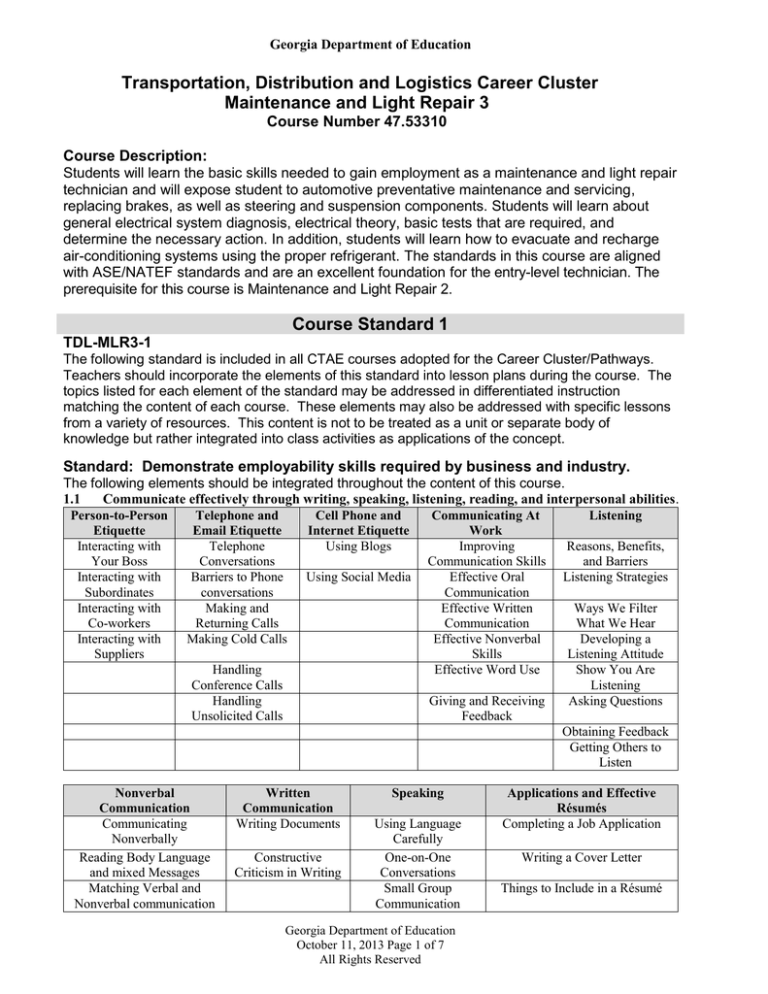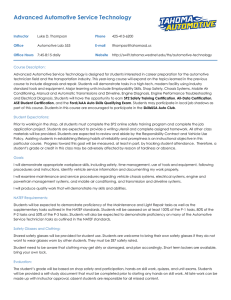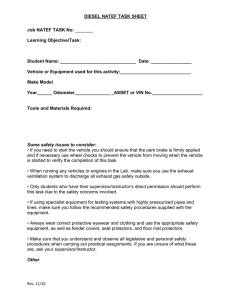
Georgia Department of Education
Transportation, Distribution and Logistics Career Cluster
Maintenance and Light Repair 3
Course Number 47.53310
Course Description:
Students will learn the basic skills needed to gain employment as a maintenance and light repair
technician and will expose student to automotive preventative maintenance and servicing,
replacing brakes, as well as steering and suspension components. Students will learn about
general electrical system diagnosis, electrical theory, basic tests that are required, and
determine the necessary action. In addition, students will learn how to evacuate and recharge
air-conditioning systems using the proper refrigerant. The standards in this course are aligned
with ASE/NATEF standards and are an excellent foundation for the entry-level technician. The
prerequisite for this course is Maintenance and Light Repair 2.
Course Standard 1
TDL-MLR3-1
The following standard is included in all CTAE courses adopted for the Career Cluster/Pathways.
Teachers should incorporate the elements of this standard into lesson plans during the course. The
topics listed for each element of the standard may be addressed in differentiated instruction
matching the content of each course. These elements may also be addressed with specific lessons
from a variety of resources. This content is not to be treated as a unit or separate body of
knowledge but rather integrated into class activities as applications of the concept.
Standard: Demonstrate employability skills required by business and industry.
The following elements should be integrated throughout the content of this course.
1.1
Communicate effectively through writing, speaking, listening, reading, and interpersonal abilities.
Person-to-Person
Telephone and
Cell Phone and
Communicating At
Listening
Etiquette
Email Etiquette
Internet Etiquette
Work
Interacting with
Telephone
Using Blogs
Improving
Reasons, Benefits,
Your Boss
Conversations
Communication Skills
and Barriers
Interacting with
Barriers to Phone
Using Social Media
Effective Oral
Listening Strategies
Subordinates
conversations
Communication
Interacting with
Making and
Effective Written
Ways We Filter
Co-workers
Returning Calls
Communication
What We Hear
Interacting with
Making Cold Calls
Effective Nonverbal
Developing a
Suppliers
Skills
Listening Attitude
Handling
Effective Word Use
Show You Are
Conference Calls
Listening
Handling
Giving and Receiving
Asking Questions
Unsolicited Calls
Feedback
Obtaining Feedback
Getting Others to
Listen
Nonverbal
Communication
Communicating
Nonverbally
Reading Body Language
and mixed Messages
Matching Verbal and
Nonverbal communication
Written
Communication
Writing Documents
Constructive
Criticism in Writing
Speaking
Using Language
Carefully
One-on-One
Conversations
Small Group
Communication
Georgia Department of Education
October 11, 2013 Page 1 of 7
All Rights Reserved
Applications and Effective
Résumés
Completing a Job Application
Writing a Cover Letter
Things to Include in a Résumé
Georgia Department of Education
Improving Nonverbal
Indicators
Nonverbal Feedback
Showing Confidence
Nonverbally
Showing Assertiveness
1.2
Large Group
Communication
Making Speeches
Involving the
Audience
Answering Questions
Visual and Media Aids
Errors in Presentation
Selling Yourself in a Résumé
Terms to Use in a Résumé
Describing Your Job Strengths
Organizing Your Résumé
Writing an Electronic Résumé
Dressing Up Your Résumé
Demonstrate creativity by asking challenging questions and applying innovative procedures and
methods.
Teamwork and Problem Solving
Meeting Etiquette
Thinking Creatively
Preparation and Participation in Meetings
Taking Risks
Conducting Two-Person or Large Group Meetings
Building Team Communication
Inviting and Introducing Speakers
Facilitating Discussions and Closing
Preparing Visual Aids
Virtual Meetings
1.3
Exhibit critical thinking and problem solving skills to locate, analyze and apply information in
career planning and employment situations.
Problem
Customer Service The Application Process
Interviewing
Finding the Right
Solving
Skills
Job
Transferable
Gaining Trust and
Providing Information,
Preparing for an
Locating Jobs and
Job Skills
Interacting with
Accuracy and Double
Interview
Networking
Customers
Checking
Becoming a
Learning and
Online Application
Questions to Ask in
Job Shopping
Problem Solver
Giving Customers
Process
an Interview
Online
What They Want
Identifying a
Keeping Customers
Following Up After
Things to Include
Job Search
Problem
Coming Back
Submitting an
in a Career
Websites
Application
Portfolio
Becoming a
Seeing the
Effective Résumés:
Traits Employers
Participation in Job
Critical Thinker
Customer’s Point
are Seeking
Fairs
Managing
Selling Yourself and Matching Your Talents to
Considerations
Searching the
the Company
a Job
Before Taking a
Classified Ads
Job
Handling Customer
When a Résumé Should
Using Employment
Complaints
be Used
Agencies
Strategies for
Landing an
Customer Service
Internship
Staying Motivated
to Search
1.4
Model work readiness traits required for success in the workplace including integrity, honesty,
accountability, punctuality, time management, and respect for diversity.
Workplace
Personal
Employer
Business Etiquette
Communicating at
Ethics
Characteristics
Expectations
Work
Demonstrating
Demonstrating a
Behaviors Employers
Language and
Handling Anger
Good Work Ethic
Good Attitude
Expect
Behavior
Behaving
Gaining and
Objectionable
Keeping Information
Dealing with
Appropriately
Showing Respect
Behaviors
Confidential
Difficult Coworkers
Maintaining
Demonstrating
Establishing
Avoiding Gossip
Dealing with a
Honesty
Responsibility
Credibility
Difficult Boss
Georgia Department of Education
October 11, 2013 Page 2 of 7
All Rights Reserved
Georgia Department of Education
Playing Fair
Using Ethical
Language
Showing
Responsibility
Reducing
Harassment
Respecting
Diversity
Making
Truthfulness a
Habit
Leaving a Job
Ethically
Showing
Dependability
Being Courteous
Gaining
Coworkers’ Trust
Persevering
Handling
Criticism
Showing
Professionalism
Demonstrating Your
Skills
Building Work
Relationships
Appropriate Work
Email
Cell Phone Etiquette
Dealing with
Difficult Customers
Dealing with Conflict
Appropriate Work
Texting
Understanding
Copyright
Social Networking
1.5
Apply the appropriate skill sets to be productive in a changing, technological, diverse workplace
to be able to work independently and apply team work skills.
Expected Work Traits
Teamwork
Time Management
Demonstrating Responsibility
Teamwork Skills
Managing Time
Dealing with Information Overload
Reasons Companies Use Teams
Putting First Things First
Transferable Job Skills
Decisions Teams Make
Juggling Many Priorities
Managing Change
Team Responsibilities
Overcoming Procrastination
Adopting a New Technology
Problems That Affect Teams
Organizing Workspace and Tasks
Expressing Yourself on a Team
Staying Organized
Giving and Receiving Constructive
Finding More Time
Criticism
Managing Projects
Prioritizing Personal and Work Life
1.6
Present a professional image through appearance, behavior and language.
On-the-Job Etiquette
Person-to-Person Etiquette Communication Etiquette
Using Professional
Meeting Business
Creating a Good Impression
Manners
Acquaintances
Introducing People
Meeting People for the First
Keeping Phone Calls
Time
Professional
Appropriate Dress
Showing Politeness
Proper Use of Work Email
Business Meal Functions
Behavior at Work
Parties
Behavior at Conventions
International Etiquette
Proper Use of Cell Phone
Proper Use in Texting
Presenting Yourself
Looking Professional
Dressing for Success
Showing a
Professional Attitude
Using Good Posture
Presenting Yourself to
Associates
Accepting Criticism
Demonstrating
Leadership
Cross-Cultural Etiquette
Working in a Cubicle
Support of CTAE Foundation Course Standards and Georgia Standards of Excellence
L9-10RST 1-10 and L9-10WHST 1-10:
Georgia Standards of Excellence ELA/Literacy standards have been written specifically for
technical subjects and have been adopted as part of the official standards for all CTAE courses.
Georgia Department of Education
October 11, 2013 Page 3 of 7
All Rights Reserved
Georgia Department of Education
Course Standard 2
TDL-MLR3-2
Identify and use safety procedures and proper tools.
2.1 Identify and use general shop safety rules and procedures.
2.2 Identify and use safe procedures for handling of tools and equipment.
2.3 Identify and use proper placement of floor jacks and jack stands.
2.4 Identify and use proper procedures for safe lift operation.
2.5 Identify and use proper ventilation procedures for working within the lab/shop area.
2.6 Identify and use marked safety areas.
2.7 Identify and demonstrate knowledge of the location and procedures for use of fire
extinguishers and other fire safety equipment.
2.8 Identify and describe the location and use of eye wash stations.
2.9 Identify and describe the location of the posted evacuation routes.
2.10 Demonstrate compliance with the required use of safety glasses, ear protection, gloves,
and shoes during lab/shop activities.
2.11 Identify and wear appropriate clothing for lab/shop activities.
2.12 Identify and demonstrate securing hair and jewelry for lab/shop activities.
2.13 Identify and demonstrate awareness of the safety aspects of supplemental restraint
systems (SRS), electronic brake control systems, and hybrid vehicle high voltage circuits.
2.14 Demonstrate awareness of the safety aspects of high voltage circuits (such as high
intensity discharge (HID) lamps, ignition systems, injection systems, etc.).
2.15 Locate and demonstrate use of material safety data sheets (MSDS).
Course Standard 3
TDL-MLR3-3
Identify and utilize proper tools and equipment tools and equipment.
3.1 Identify and use tools in automotive applications.
3.2 Identify and use standard and metric designations.
3.3 Demonstrate safe handling and use of appropriate tools.
3.4 Demonstrate proper cleaning, storage, and maintenance of tools and equipment.
3.5 Demonstrate proper use of precision measuring tools (i.e. micrometer, dial-indicator, and
dial-caliper).
Course Standard 4
TDL-MLR3-4
Identify and utilize vehicle service information.
4.1 Identify and use information needed and the service requested on a vehicle service
repair order.
4.2 Identify the purpose and demonstrate proper use of fender covers, mats.
4.3 Demonstrate use of the three C’s (concern, cause, and correction) for vehicle service
information.
4.4 Complete a work order that includes customer information, vehicle identifying
information, customer concern, related service history, cause, and correction.
4.2 Identify the proper procedure to ensure that a vehicle is prepared to return to the
customer per school/company policy (floor mats, steering wheel cover, etc.).
Georgia Department of Education
October 11, 2013 Page 4 of 7
All Rights Reserved
Georgia Department of Education
Course Standard 5
TDL-MLR3-5
Demonstrate general engine service techniques (engine repair general).
5.1 Demonstrate removing and replacing timing belts and verify correct camshaft timing.
[NATEF I-A-5]
5.2 Identify and verify hybrid vehicle internal combustion engine service precautions.
[NATEF I-A-7]
5.2 Demonstrate and verify adjusting valves (mechanical or hydraulic lifters) related to the
cylinder head and valve train. [NATEF I-B-1]
Course Standard 6
TDL-MLR3-6
Perform general automatic transmission & manual transaxle & differential service.
6.1 Inspect and perform adjustments and replacements of external manual valve shift linkage,
transmission range sensor/switch, and park/neutral position switches. [NATEF II-B-1]
6.2
6.3
6.4
6.5
6.5
6.6
Describe and perform adjustments and replacements related to the operational
characteristics of a continuously variable transmission. [NATEF II-C-1]
Describe and perform adjustments and replacements related to operational characteristics of
an electronically-controlled manual transmission/transaxle. [NATEF III-C-1]
Inspect and perform adjustments and replacements for front wheel drive (FWD)
bearings, hubs, and seals. [NATEF III-D-1]
Inspect and perform adjustments and replacements for shafts, yokes, boots, and
universal/CV joints. [NATEF III-D-2]
Inspect and perform adjustments and replacements for drive axle wheel studs. [NATEF
III-F-1]
Inspect and perform adjustments and replacements for front-wheel bearings and locking
hubs. [NATEF III-F-1]
Course Standard 7
TDL-MLR3-7
Prepare vehicle for general suspension and steering systems service.
7.1 Inspect and prepare power steering hoses and fittings. [NATEF IV-B-6]
7.2 Inspect and prepare the strut cartridge or assembly. [NATEF IV-B-16]
7.3 Inspect and prepare the front strut bearing and mount. [NATEF IV-B-17]
7.4 Inspect and prepare the rear suspension system leaf spring(s), spring insulators
(silencers), shackles, brackets, bushings, center pins/bolts, and mounts. [NATEF IV-B-19]
7.5 Inspect and prepare the electric power-assisted steering. [NATEF IV-B-21]
7.6 Identify and prepare hybrid vehicle power steering system electrical circuits and safety
precautions. [NATEF IV-B-22]
Course Standard 8
TDL-MLR3-8
Perform hydraulic brake system service and repairs.
8.1 Determine necessary action required after measuring brake pedal height, travel, and free
play (as applicable). [NATEF V-B-1]
8.2 Check brake pedal travel, with and without the engine running to and verify proper power
booster operation. [NATEF V-E-1]
8.3 Identify and verify traction control/vehicle stability control system components. [NATEF V-G-1]
8.4 Analyze the operation of a regenerative braking system. [NATEF V-G-2]
Georgia Department of Education
October 11, 2013 Page 5 of 7
All Rights Reserved
Georgia Department of Education
Course Standard 9
TDL-MLR3-9
Perform general electrical systems service.
9.1 Perform and use wiring diagrams to trace electrical/electronic circuits. [NATEF VI-A-3]
9.2 Demonstrate the proper use of a digital multimeter (DMM) when measuring source
voltage, voltage drop (including grounds), current flow, and resistance. [NATEF VI-A-4]
9.3 Demonstrate and summarize causes and effects from shorts, grounds, opens, and
resistance problems in electrical/electronic circuits. [NATEF VI-A-5]
9.4 Describe and verify the operation of electrical circuits. [NATEF VI-A-6]
9.5 Describe and verify the operation of electrical circuits with fused jumper wires. [NATEF
VI-A-7]
9.6 Describe and measure key-off battery drain (parasitic draw). [NATEF VI-A-8]
9.7 Demonstrate the proper procedure to replace electrical connectors and terminal ends.
[NATEF VI-A-11]
9.8 Identify and test procedures of the hybrid vehicle auxiliary (12v) battery service, including
repair, and test procedures. [NATEF VI-B-9]
9.9 Determine necessary action required after inspecting and testing starter relays and
solenoids. [NATEF VI-C-3]
9.10 Demonstrate the proper procedure to remove and install a starter in a vehicle. [NATEF VI-C-4]
9.11 Determine necessary action required after inspecting and testing switches, connectors,
and wires of starter control circuits. [NATEF VI-C-5]
9.12 Demonstrate the proper procedure to remove, inspect, and re-install a generator
(alternator). [NATEF VI-D-3]
9.13 Demonstrate the proper procedure to aim headlights. [NATEF VI-E-2]
9.14 Describe system voltage and safety precautions associated with high-intensity discharge
headlights. [NATEF VI-E-3]
9.15 Demonstrate the proper procedure to remove and reinstall a door panel. [NATEF VI-F-2]
9.16 Describe the proper operation of keyless entry/remote-start systems. [NATEF VII-F-3]
Course Standard 10
TDL-MLR3-10
Demonstrate knowledge of air conditioning systems.
10.1 Summarize hybrid vehicle air conditioning system electrical circuits and the
service/safety precautions. [NATEF VII-B-2]
10.2 Perform necessary action required after inspecting the engine cooling and heater
systems hoses. [NATEF VII-C-1]
10.3 Perform necessary action required after inspecting air conditioning-heater ducts, doors,
hoses, cabin filters, and outlets. [NATEF VII-D-1]
10.4 Predict sources of air conditioning system odors. [NATEF VII-D-2]
Course Standard 11
TDL-MLR3-11
Analyze engine performance.
11.1 Determine necessary action required after performing engine absolute (vacuum/boost)
manifold pressure tests. [NATEF VIII-A-2]
11.2 Determine necessary action required after performing a cylinder power balance test.
[NATEF VIII-A-3]
11.3 Determine necessary action required after performing cylinder cranking and running
compression tests. [NATEF VIII-A-4]
Georgia Department of Education
October 11, 2013 Page 6 of 7
All Rights Reserved
Georgia Department of Education
11.4 Determine necessary action required after performing a cylinder leakage test. [NATEF
VIII-A-5]
11.5 Demonstrate the proper procedure to remove and replace spark plugs after inspecting
secondary ignition components for wear and damage. [NATEF VIII-A-7]
11.6 Analyze the engine performance after retrieving and recording diagnostic trouble codes,
On-Board Diagnostics (OBD) monitor status, freeze frame data; and clear codes, when
applicable. [NATEF VIII-B-1
11.7 Describe the importance of operating all On-Board Diagnostics (OBDII) monitors for
repair verification. [NATEF VIII-B-2]
11.8 Perform necessary action required after inspecting, testing the service positive
crankcase ventilation (PCV) filter/breather cap, valves, tubes, orifices, and hoses.
[NATEF VIII-D-1]
Course Standard 12
TDL-MLR3-12
Examine how SkillsUSA is a co-curricular part of career and technical education
through leadership development, school and community service projects, and
competitive events.
12.1 Explain the purpose, mission, objectives, motto, colors, official dress and other
distinguishing characteristics of SkillsUSA.
12.2 Explain how participation in SkillsUSA can promote lifelong responsibility for community
service, professional growth and development.
12.3 Explore the impact and opportunities that SkillsUSA can develop to bring business and
industry together with education in a positive working relationship through innovative
leadership and career development programs.
12.4 Explore the local, state, and national opportunities available to students through
participation in SkillsUSA, including, but not limited to conferences, competitions,
community service, philanthropy, and other SkillsUSA activities.
Georgia Department of Education
October 11, 2013 Page 7 of 7
All Rights Reserved




